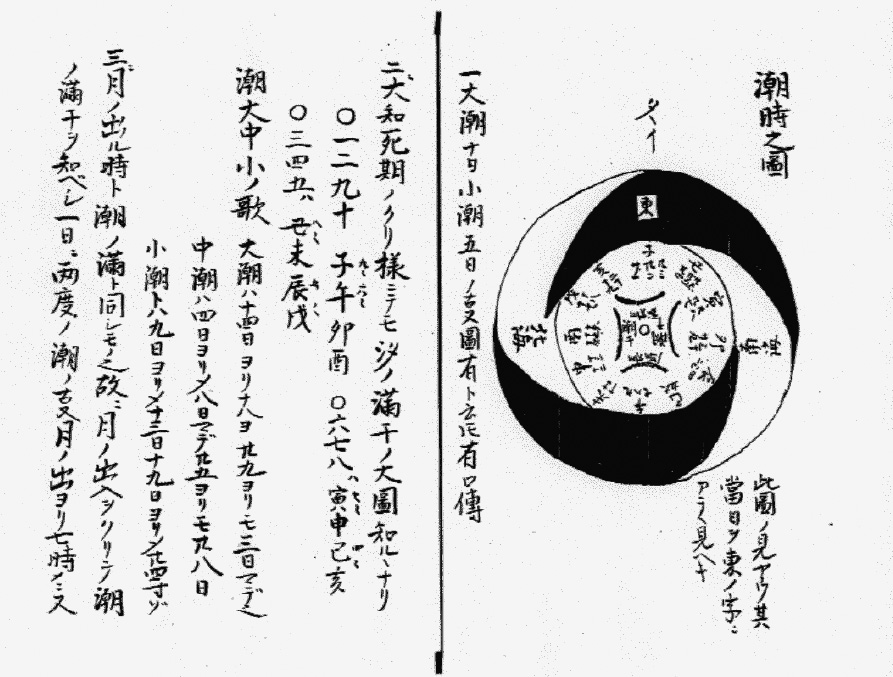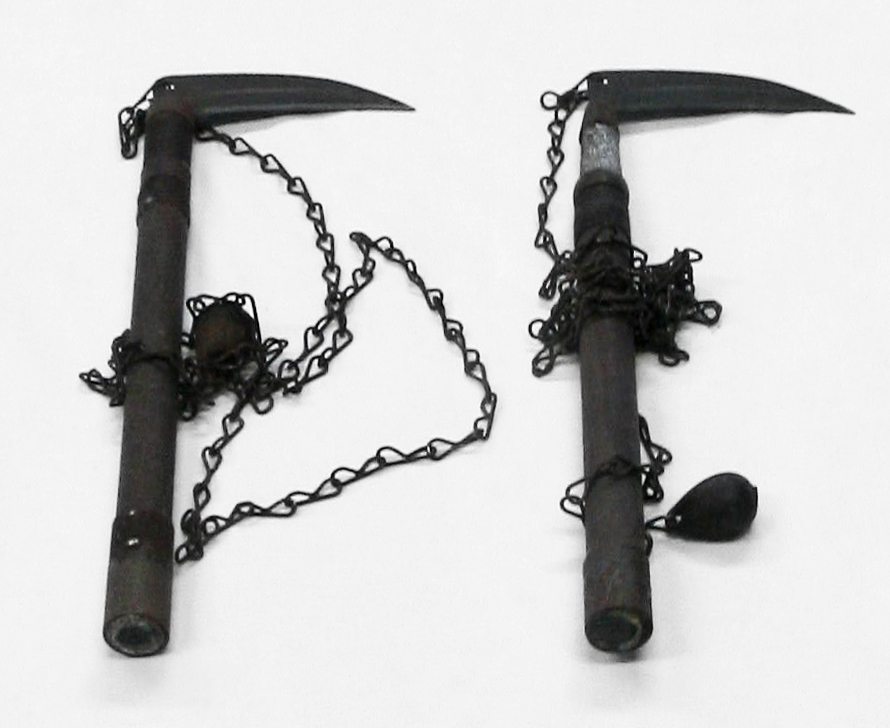|
Bugei Jūhappan
The Bugei jūhappan (武芸十八般 "Eighteen Kinds Of Martial Arts") is a selection of combat techniques and martial arts used by the samurai of Tokugawa-era Japan. Established by Hirayama Gyozo, the concept is based on earlier Chinese traditions, such as Eighteen Arms of Wushu. Eighteen arts file:Heki Ryu Kyujutsu.jpg, 300px, 1. Kyūjutsu file:Kozaemon Hisamitsu mounted and armored, but bareheaded, on his galloping steed.jpg, 300px, 2. Bajutsu The Eighteen Arts consist of native Japanese martial arts techniques and tactics. Within each art, various Ryū (school), ''Ryū'' developed, with different methods of performing that particular art. Certain ''Ryū,'' in turn, influenced the martial arts that were included in the list, Asayama Ichiden-ryū, Kukishin-ryū, Shinden-Fudo-ryū and Tagaki Yoshin-ryū. The exact list varies, but is commonly held to include: # Kyujutsu, ''Kyūjutsu'', archery. # ''Bajutsu'', horseriding. # Sojutsu, ''Sōjutsu'', fighting with a ''yari'' (spe ... [...More Info...] [...Related Items...] OR: [Wikipedia] [Google] [Baidu] |
Martial Arts
Martial arts are codified systems and traditions of combat practiced for a number of reasons such as self-defence; military and law enforcement applications; combat sport, competition; physical, mental, and spiritual development; entertainment; and the preservation of a nation's intangible cultural heritage. The concept of martial arts was originally associated with East Asian tradition, but subsequently the term has been applied to practices that originated outside that region. Etymology "Martial arts" is a direct English translation of the Sino-Japanese word (, ). Literally, it refers to "武 martial" and "芸 arts". The term ''martial arts'' was popularized by mainstream popular culture during the 1960s to 1970s, notably by Hong Kong action cinema, Hong Kong martial arts films (most famously those of Bruce Lee) during the so-called "chopsocky" wave of the early 1970s. According to John Clements, the term '':wikt:martial art, martial arts'' itself is derived from an older ... [...More Info...] [...Related Items...] OR: [Wikipedia] [Google] [Baidu] |
Tantojutsu
Tantōjutsu (短刀術) is a Japanese term for a variety of traditional Japanese knife fighting systems that used the tantō (短刀), as a knife or dagger. Historically, many women used a version of the tantō, called the kaiken, for self-defense, but onna-musha, warrior women in pre-modern Japan learned one of the tantōjutsu arts to fight in battle. Martial arts that practise tantōjutsu Tantō with blunt wooden or plastic blades are used to practice martial arts. Metal blades can be used in more advanced training and in demonstrations. Styles that use tantō: Budō (Gendai): * Aikido * Shorinji Kempo Bugei: * Yanagi-ryū Aiki Bugei (Yoshida-ha Shidare Yanagi-ryū) * Ogawa-ryu Bugei Bujutsu (Koryū): * Kashima Shin-ryū (this ''ryū (school), ryūha'' uses term Kaikenjutsu) * Takamura-ha Shindo Yoshin-ryu * Tendō-ryū See also * Kaiken (dagger) * Wakizashi References Japanese martial arts Japanese martial arts terminology Edged and bladed weapons {{Martialart-term ... [...More Info...] [...Related Items...] OR: [Wikipedia] [Google] [Baidu] |
Ninjutsu
, and are terms for the techniques and skills used by spies and scouts in pre-modern Japan known as ninja. Some of these techniques are recorded in ninja scrolls, some which have been published and translated. The study of these scrolls have changed the perception of ninja and ninjutsu. While there are martial arts schools that claim to be Modern schools of ninjutsu, modern styles of ''ninjutsu'', the historical lineage of these styles only go as far back as the 1950s. Training The skills required of the ninja have come to be known in modern times as , but it is unlikely they were previously named under a single discipline, rather distributed among a variety of espionage and survival skills. Some view ''ninjutsu'' as evidence that ninja were not simple mercenaries because texts contained not only information on combat training, but also information about daily needs, which even included mining techniques. The guidance provided for daily work also included elements that enable ... [...More Info...] [...Related Items...] OR: [Wikipedia] [Google] [Baidu] |
Kusarigama
A is a traditional Japanese weapon that consists of a '' kama'' (the Japanese equivalent of a sickle or billhook) on a kusari-fundo – a type of metal chain (''kusari'') with a heavy iron weight (''fundo'') at the end. The ''kusarigama'' is said to have been developed during the Muromachi period. The art of handling the kusarigama is called '' kusarigamajutsu''. History The researcher Nawa Yumio believes that the ''kusarigama'' was based on the ''jingama'', a tool that resembles a sickle, which was used to cut through a horse's ropes in the case of a fire. The ''jingama'' could also be used as a weapon and according to Nawa, the tool might have been combined with a , which is a chain that contained a weighted end and a chain around the user's wrist. People would wield the weapons with both hands to protect their horses against criminals. Another theory is that the ''kusarigama'' is based on the ''tobiguchi'' ( :ja:鳶口), which is a type of axe that had a "stout haft and a s ... [...More Info...] [...Related Items...] OR: [Wikipedia] [Google] [Baidu] |
Kusarigamajutsu
is the art of using the Japanese weapon kusarigama. Kusarigamajutsu is featured in several separate martial arts such as Tendō-ryū, Suiō-ryū and Shintō Musō-ryū. The kusarigama is made up of three parts: the ''kama'' (a wooden handle with a curved blade (traditionally straight) protruding at a right-angle on one end, and a small loop at the other), and the ''kusari'' (a chain attached to the kama) and a weight at the end of the chain. In a confrontation the kusari is swung in wide sweeping arcs to distract and entangle the opponent and the kama is used to deliver a fatal strike. Martialartsaus.com. Accessed June 2, 2012. Popular culture * '' |
Jujutsu
Jujutsu ( , or ), also known as jiu-jitsu and ju-jitsu (both ), is a Japanese martial art and a system of close combat that can be used in a defensive or offensive manner to kill or subdue one or more weaponless or armed and armored opponents. A subset of techniques from certain styles of jujutsu were used to develop many modern martial arts and combat sports, such as judo, aikido, sambo, Brazilian jiu-jitsu, ARB, and mixed martial arts. Characteristics " Jū" can be translated as "gentle, soft, supple, flexible, pliable, or yielding", and " jutsu" can be translated as "art or technique". "Jujutsu" thus has the meaning of "yielding-art", as its core philosophy is to manipulate the opponent's force against themself rather than confronting it with one's own force. Jujutsu developed to combat the samurai of feudal Japan as a method for defeating an armed and armored opponent in which one uses no form of weapon, or only a short weapon. Because striking against an armored ... [...More Info...] [...Related Items...] OR: [Wikipedia] [Google] [Baidu] |
Naginata
The ''naginata'' (, , ) is a polearm and one of several varieties of traditionally made Japanese blades ('' nihontō''). ''Naginata'' were originally used by the samurai class of feudal Japan, as well as by ashigaru (foot soldiers) and sōhei (warrior monks). The naginata is the iconic weapon of the onna-musha, a type of female warrior belonging to the Japanese nobility. A common misconception is that the Naginata is a type of sword, rather than a polearm. Description A ''naginata'' consists of a wooden or metal pole with a curved single-edged blade on the end; it is similar to the Chinese guan dao or the European glaive. Similar to the katana, naginata often have a round handguard (''tsuba'') between the blade and shaft, when mounted in a koshirae (furniture). The ''naginata'' blade is forged in the same manner as traditional Japanese swords. The blade has a long tang (''nakago'') which is inserted in the shaft. The blade is removable and is secured by means of a wooden p ... [...More Info...] [...Related Items...] OR: [Wikipedia] [Google] [Baidu] |
Naginatajutsu
is the Japanese martial art of wielding the . The naginata is a weapon resembling the European glaive and the Chinese Guandao, guan dao. Most naginatajutsu practiced today is in a modernized form, a ''gendai budō'', in which competitions also are held. History Origins The ''naginata'' originates from development of the Japanese spear called ''hoko yari'' of the later 1st millennium AD. It has been suggested that it developed along the same lines as Okinawan kobudō weapons as a modified farming tool. Others say that creative samurai in need of a longer weapon attached a sword to a pole. Perhaps the simplest explanation is the natural development of polearms. Polearms are intended as mass weapons, to be used not just by individual warriors, but by formations of soldiers together on field battles and not for dueling. When fighting in close order, two-handed cut-and-thrust weapons, such as halberds and glaives, are much more efficient than mere spears or swords because of their v ... [...More Info...] [...Related Items...] OR: [Wikipedia] [Google] [Baidu] |
Shuriken
A is a Japanese concealed weapon used by samurai or ninja or in martial arts as a hidden dagger or '' metsubushi'' to distract or misdirect. History The origins of the ''bo-shuriken'' in Japan are still unclear, despite continuing research. This is partly because shurikenjutsu was a secret art and also due to the fact that throughout early Japanese history there were many independent exponents of the skill of throwing long, thin objects. The earliest-known reference to a school teaching shurikenjutsu is Ganritsu Ryu, active during the 17th century. This school utilized a long, thin implement with a bulbous head, thought to be derived from the arrow. Surviving examples of blades used by this school appear to combine an arrow's shape with that of a needle traditionally used in Japanese leatherwork and armor manufacture. There are earlier mentions in written records, such as the , of the standard knife and short sword being thrown in battle. Miyamoto Musashi is said ... [...More Info...] [...Related Items...] OR: [Wikipedia] [Google] [Baidu] |





